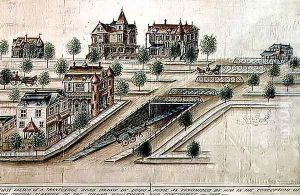Louis A. Risse Paintings
Louis A. Risse was not a traditional artist but an influential figure in the realm of urban planning and civil engineering, particularly known for his work in New York City. Born in France in 1850, Risse immigrated to the United States and became an important figure in the development of the city’s infrastructure during the late 19th and early 20th centuries.
Risse is best remembered for his grand vision in designing the Grand Concourse in the Bronx, a major thoroughfare that was inspired by the Champs-Élysées in Paris. The Grand Concourse, originally known as the Grand Boulevard and Concourse, was designed to provide a north-south route through the borough of the Bronx and includes wide, landscaped medians with pedestrian paths, enhancing both transportation and the aesthetics of the area. The boulevard was intended to encourage development in the Bronx, which at the time was less urbanized than other parts of New York City.
The construction of the Grand Concourse began in 1894 and was completed in 1909. It stretches over four miles and is lined with various types of buildings, including Art Deco and Art Moderne apartment houses, which later became emblematic of the boulevard's style during the 1920s and 1930s. The Grand Concourse has since been recognized for its architectural significance and was listed on the National Register of Historic Places in 1987.
Throughout his career, Risse worked as an engineer for what would later become the New York City Department of Transportation. His work contributed significantly to the city's development during a time of rapid growth and transformation. Risse's planning and designs helped shape the urban landscape of New York, and his influence can still be seen in the city's infrastructure today.
Louis A. Risse passed away in 1925, but his legacy as a visionary urban planner endures, particularly in the Bronx, where the Grand Concourse remains a vital and iconic artery. His work is a testament to the impact that thoughtful urban design can have on the livability and character of a city.
